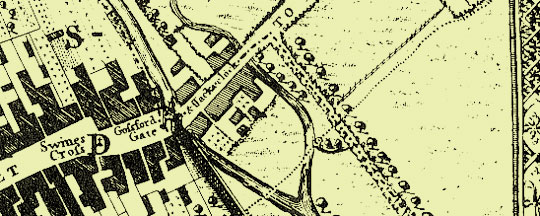Home » Yesterday » Development of a Street

Far Gosford Street was the main route out of medieval Coventry towards Leicester and London.
There were already houses on the street as early as the 12th century. The late 18th and 19th centuries saw the growth of silk and ribbon weaving which came to be the predominant trades in the street as elsewhere in the city. The distinctive top shops were associated with this trade and the grade II listed no 67 -72 remain a good example of this building type. After the weaving industry declined, cycle manufacture took over followed by the motor car industry. The city was at the heart of the rapid development the motor vehicle in England and many of the early factories were located in this area.
Far Gosford Street is one of the few streets in Coventry to have survived the combined effect of modernisation, the effect of dilapidation and the Blitz. Both the medieval street and some of its buildings are preserved.
Much of the city centre was destroyed in the November 1940 Blitz, but Far Gosford Street largely escaped serious damage. As a result, the street thrived as a shopping area while the city centre was gradually being rebuilt. Far Gosford Street was blighted by a plan to build a by-pass road. Sky Blue Way was opened in 1986, diverting much through-traffic and passing trade. Decline set in, businesses began to move away and buildings deteriorated.
Eventually the historical and architectural importance of the street was recognised by the declaration of the Far Gosford Street Conservation Area in 1992. From then on all planning proposals needed to demonstrate how they preserved or enhanced the character and appearance of the conservation area. In 2005 the Townscape Heritage Initiative was established, funded by the Heritage Lottery Fund and Coventry City Council, and the economic and physical regeneration of the street began. The regeneration programme has since expanded and attracted regional development funding and the European Regional Development Fund, as well as a private sector development partner, Complex Development Projects Ltd.
In 2012 the appearance and economy of the street has improved significantly, with the completion of some important building and restoration projects and their occupation by new businesses. This marks a new phase in the story of the street, which will be no longer characterised by decline, but by economic prosperity within a regenerated historic environment.